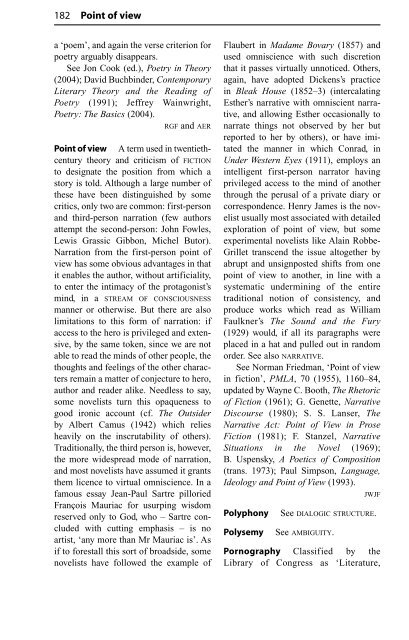The Routledge Dictionary of Literary Terms
The Routledge Dictionary of Literary Terms
The Routledge Dictionary of Literary Terms
You also want an ePaper? Increase the reach of your titles
YUMPU automatically turns print PDFs into web optimized ePapers that Google loves.
182 Point <strong>of</strong> view<br />
a ‘poem’, and again the verse criterion for<br />
poetry arguably disappears.<br />
See Jon Cook (ed.), Poetry in <strong>The</strong>ory<br />
(2004); David Buchbinder, Contemporary<br />
<strong>Literary</strong> <strong>The</strong>ory and the Reading <strong>of</strong><br />
Poetry (1991); Jeffrey Wainwright,<br />
Poetry: <strong>The</strong> Basics (2004).<br />
RGF and AER<br />
Point <strong>of</strong> view A term used in twentiethcentury<br />
theory and criticism <strong>of</strong> FICTION<br />
to designate the position from which a<br />
story is told. Although a large number <strong>of</strong><br />
these have been distinguished by some<br />
critics, only two are common: first-person<br />
and third-person narration (few authors<br />
attempt the second-person: John Fowles,<br />
Lewis Grassic Gibbon, Michel Butor).<br />
Narration from the first-person point <strong>of</strong><br />
view has some obvious advantages in that<br />
it enables the author, without artificiality,<br />
to enter the intimacy <strong>of</strong> the protagonist’s<br />
mind, in a STREAM OF CONSCIOUSNESS<br />
manner or otherwise. But there are also<br />
limitations to this form <strong>of</strong> narration: if<br />
access to the hero is privileged and extensive,<br />
by the same token, since we are not<br />
able to read the minds <strong>of</strong> other people, the<br />
thoughts and feelings <strong>of</strong> the other characters<br />
remain a matter <strong>of</strong> conjecture to hero,<br />
author and reader alike. Needless to say,<br />
some novelists turn this opaqueness to<br />
good ironic account (cf. <strong>The</strong> Outsider<br />
by Albert Camus (1942) which relies<br />
heavily on the inscrutability <strong>of</strong> others).<br />
Traditionally, the third person is, however,<br />
the more widespread mode <strong>of</strong> narration,<br />
and most novelists have assumed it grants<br />
them licence to virtual omniscience. In a<br />
famous essay Jean-Paul Sartre pilloried<br />
François Mauriac for usurping wisdom<br />
reserved only to God, who – Sartre concluded<br />
with cutting emphasis – is no<br />
artist, ‘any more than Mr Mauriac is’. As<br />
if to forestall this sort <strong>of</strong> broadside, some<br />
novelists have followed the example <strong>of</strong><br />
Flaubert in Madame Bovary (1857) and<br />
used omniscience with such discretion<br />
that it passes virtually unnoticed. Others,<br />
again, have adopted Dickens’s practice<br />
in Bleak House (1852–3) (intercalating<br />
Esther’s narrative with omniscient narrative,<br />
and allowing Esther occasionally to<br />
narrate things not observed by her but<br />
reported to her by others), or have imitated<br />
the manner in which Conrad, in<br />
Under Western Eyes (1911), employs an<br />
intelligent first-person narrator having<br />
privileged access to the mind <strong>of</strong> another<br />
through the perusal <strong>of</strong> a private diary or<br />
correspondence. Henry James is the novelist<br />
usually most associated with detailed<br />
exploration <strong>of</strong> point <strong>of</strong> view, but some<br />
experimental novelists like Alain Robbe-<br />
Grillet transcend the issue altogether by<br />
abrupt and unsignposted shifts from one<br />
point <strong>of</strong> view to another, in line with a<br />
systematic undermining <strong>of</strong> the entire<br />
traditional notion <strong>of</strong> consistency, and<br />
produce works which read as William<br />
Faulkner’s <strong>The</strong> Sound and the Fury<br />
(1929) would, if all its paragraphs were<br />
placed in a hat and pulled out in random<br />
order. See also NARRATIVE.<br />
See Norman Friedman, ‘Point <strong>of</strong> view<br />
in fiction’, PMLA, 70 (1955), 1160–84,<br />
updated by Wayne C. Booth, <strong>The</strong> Rhetoric<br />
<strong>of</strong> Fiction (1961); G. Genette, Narrative<br />
Discourse (1980); S. S. Lanser, <strong>The</strong><br />
Narrative Act: Point <strong>of</strong> View in Prose<br />
Fiction (1981); F. Stanzel, Narrative<br />
Situations in the Novel (1969);<br />
B. Uspensky, A Poetics <strong>of</strong> Composition<br />
(trans. 1973); Paul Simpson, Language,<br />
Ideology and Point <strong>of</strong> View (1993).<br />
JWJF<br />
Polyphony See DIALOGIC STRUCTURE.<br />
Polysemy See AMBIGUITY.<br />
Pornography Classified by the<br />
Library <strong>of</strong> Congress as ‘Literature,

















